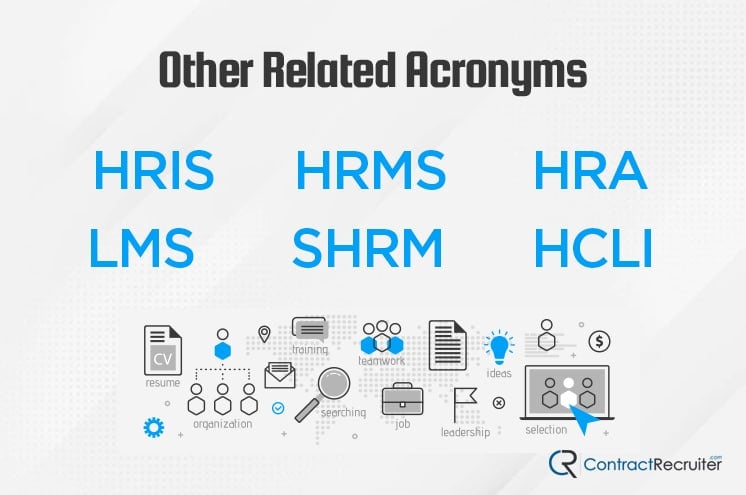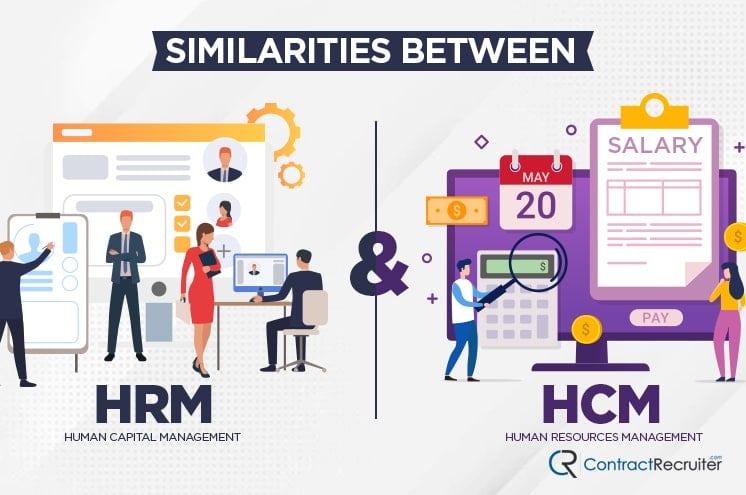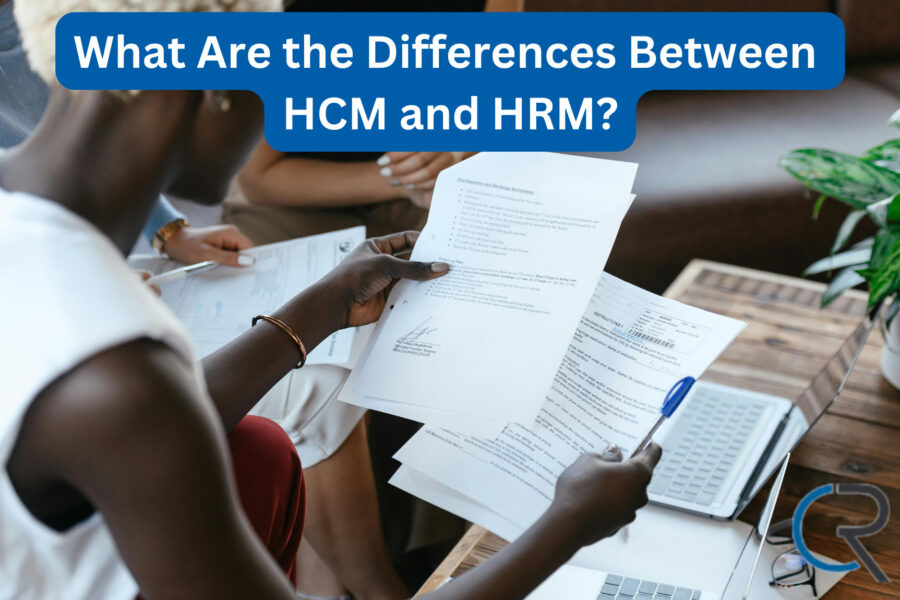The world of HR is filled with all manner of terminology, from the common to the arcane. Moreover, some of these terms are commonly treated as interchangeable, despite having their specific nuances. Many of them are practically synonyms; virtually identical in meaning, but with different connotations.
The two specific acronyms that we’re referring to today are HRM and HCM. It’s common to see these two used to mean the same thing, but are there major differences between them? Or is it a matter of which culture you come from determining the acronym that you prefer to use?
In this guide, we’ll define and compare the two to help you understand the differences between HCM and HRM.
Let’s get started!
Basic Definitions
First, we’ll start with some simple definitions. What do the acronyms stand for in the first place?
HRM stands for Human Resources Management.
HCM stands for Human Capital Management.
Both terms refer to the common human resources goal of achieving a stronger, better-managed company through the appropriate management of human workers at all levels of the organization. Decades ago, HR was typically management, handling paperwork, behind-the-scenes benefits, and other organizational functions. As technology has evolved, the duties of HR and the challenges they face every day have evolved with it. HR is no longer a facilitator of business success, but a core component of that success.
From ADP:
“The term human resources suggests something of limited quantity, whereas human capital implies an ongoing relationship of value.”
Likewise, from EPAY Systems:
“HCM is the more all-encompassing term, describing functions that are part of the strategic management of human capital in an organization from talent and applicant tracking to time and attendance and analytics.”
Human Capital Management encompasses Human Resources Management, as well as more broadly-focused organizational management, integrated into the overall objectives of the business.
Other Related Acronyms
In addition to HRM and HCM, there are several other acronyms you may encounter in discussions of human resources.


These include:
- Human Resources Management Systems. Human Resource Management encompasses all of the human resources fields, including tasks and tools, as well as the employees that manage those duties every day at work. HRMS is the systems those human resources employees use, as well as the processes involved. Often used interchangeably with HRIS.
- Human Resources Information Systems. This term is often used interchangeably with HRMS. In other words, HRIS and HRMS are the same.
- Human Resources Administration. This is a subset of overall human resources management and relates specifically to administrating the human resources department. HRA can involve the employees in human resources, specifically directors, the Chief Human Resources Officer, and other high-level decision-makers.
- Learning Management System. This refers to a sub-set of human resources management typically focused on the training and improvement of employees. This may be as simple as e-learning and an internal knowledge base for onboarding, or it might include everything relevant to employee growth, including the budget for external training and certification.
- The Society for Human Resources Management. One of several authorities on the overall human resources subject.
- The Human Capital Leadership Institute. One of several authorities on the topic of human capital management.
As with many business applications, the world of HR has built itself up over decades to include a wide range of arcane terminology that may not be clear to newcomers and neophytes in the industry.
Defining HRM
Looking deeper into human resources management, we can see all of the core features of HR narrowed down to specific duties and responsibilities.
“HRM is about hiring the right people, managing workforces effectively, and optimizing productivity. As a software application, it typically includes the following features, depending on the provider: Payroll, Benefits Administration, Time and Attendance, Recruitment, and Talent Management.”
Looking at each one of those responsibilities in greater detail:
- The HRM system or platform typically is responsible for managing payroll and budgeting, whether hourly or salaried, for employees and contractors. The department or software system also manages bonuses, disbursements, and other irregular financial incentives for employees.
- The HRM system is responsible for managing benefits beyond financial compensation for employees. Benefits such as healthcare, childcare, leave, travel reimbursement, retirement investments, and ongoing training can all be covered in whole or in part by the HRM system.
- Managing time clocks, attendance reviews, check-ins, and other aspects of time and attendance is all part of HRM, typically using an automated time clock system.
- The duties of the HR department encompass recruitment and hiring for the organization. Software that encompasses HRM duties can include features for candidate management, from initial contacts to keeping cold leads warm to automatically filtering applications. Stand-alone platforms like Application Tracking Systems may be part of an overall HRM solution.
- Talent Management. The relationship with an employee does not end once they are hired. HRM encompasses talent management, reviewing and adjusting the relationship the company has with an employee over the years, adjusting for the changing needs and situations of both the company and the individual.
While this may sound all-encompassing for a business’s human resources needs, the fact is that HRM tends to be the narrower and more focused of the two compared to HCM. HRM deals with immediate needs, short-term needs, and mid-term needs, and only serves to assist with some long-term decision-making.
Defining HCM
HCM is less consistently defined amongst major organizations. Most definitions find one source of commonality: the use of software and overarching data harvesting to make or assist in making, long-term, large-scale decisions for a company. HCM makes overall, strategic decisions, while HRM focuses more on day-to-day operations.
ADP does not identify specific responsibilities of an HCM platform, but rather the overall challenges that HCM can assist in.
- Evolving workplace demographics.
- Managing an increasing number of contract-based workers.
- Assisting with compliance in increasingly regulated industries.
- Reviewing the dynamics of team-based work structures.
Other definitions come from other sources. For example, the research firm Gartner offers this:
“According to the research firm, there are four key areas of human resources that HCM solutions support:
- HR administration (payroll, requesting time off, etc.)
- HR service delivery (access to company policies, procedures, documents, etc.)
- Talent Management
- Workforce Management (time and attendance tracking, shift scheduling, absence management, etc.)
More specifically, some of the features an HCM solution offers include all of the capabilities of an HRIS and HRMS solution, payroll, employee shift scheduling, employee time tracking, Applicant Tracking Systems (ATS), training, onboarding, budget planning, and absence management.”
In other words, human capital management encompasses all of what human resources management does, as well as additional duties for organization-wide, long-term decision-making. HCM is higher-level and helps assist C-level executives in their strategic decision-making.
Similarities Between HRM and HCM
There are a lot of areas where HRM and HCM are similar or identical.


For example:
- Both systems make use of modern automation tools to streamline responsibilities and assist in making decisions. Labor-intensive work such as managing payroll, tracking timekeeping, and even application tracking are all partially or fully automated with some level of human review to ensure the systems stay on target.
- Self-service. Modern HR systems are often designed to allow individual employees and contractors to log into a system and manage their details directly. They may be able to clock in and out, request leave, manage benefits, and perform other tasks directly without needing to contact anyone within HR, saving time and money.
- Artificial intelligence. The integration of modern AI systems helps HRM and HCM systems handle different aspects of human resources automatically. Chatbots can filter candidates, AI can review and filter applications, and more.
- Laws and regulations are generally rigid and can be codified in computer systems, which can then integrate with data harvesting and user inputs to automatically review your business compliance, and issue notifications when compliance is breached, so it can be identified before an audit and fixed before sanctions.
Overall, the differences between HCM and HRM are very small. Both options typically differ more in scope than in responsibilities.
Picking the Right System for Your Business
Choosing between HCM and HRM is surprisingly tricky, particularly when the line between the two is often blurred, particularly by the companies selling their systems for managing one or the other. Indeed, choosing the right system comes down to answering specific, systemic questions about your brand.
What is the size and scale of your business or organization? Typically, smaller businesses have needed more day-to-day management that comes part and parcel with human resources management (HRM) solutions. Small businesses tend to have problems of labor, where a human resources department may be understaffed and overworked with the need to manage the details of the entire rest of the company, including pay, benefits, timekeeping, and other bookkeeping tasks.
Thus, an HRM platform that can automate, streamline, and offer self-service options for many of these duties frees up the time of the human resources workers, who can then contribute more to the overall analysis of the company, offer advice on strategic decisions, and identify shortcomings in existing systems.
Conversely, HCM systems are generally required for much larger organizations. Larger organizations typically have problems with scale. It’s not a matter of setting up automatic management of payroll for a company, but keeping that automatic payroll on track in an organization of thousands or tens of thousands of employees, if not more. Challenges include identifying and watching for those who “fall through the cracks”, bugs or loopholes in the existing systems that can be exploited.
Additionally, HCM typically offers more large-scale analytics, monitoring, and reporting on how the organization as a whole is performing. This information can be reported to the executives and c-suite teams that direct the overall path of the business, empowering them to make high-level decisions regarding hiring, payroll, budgeting, internal improvement, and more.
What are the common problems you need a human management system to solve? The first step to determining whether or not your organization needs a new software solution, a new employee, or a new director, is identifying the problems you need to solve.
Does your organization have issues with delays in management, inconsistencies in bookkeeping, a lack of self-service options for employees, or other day-to-day tasks? If so, chances are good that your organization can benefit from an HRM system.
Does your organization have issues with scope and scale, the bulk management and analysis of employees and their behavior, or large-scale decision-making? If so, an HCM solution may be more appropriate.
It’s also worth mentioning that HRM systems tend to be more specialized, and thus often cost less than an HCM solution. However, a company may end up purchasing and implementing multiple HRM platforms for different elements of management. For example, your business might have an application tracking system, a payroll and benefits system, and a timekeeping system, operating simultaneously.
This introduces challenges with integrations between each platform. If they don’t export and import data nicely, this can introduce bugs and issues in the overall system.
HCM systems tend to be larger and more comprehensive. One single HCM system might include application tracking, candidate management, payroll, benefits, timekeeping, reimbursements, analytics, KPI monitoring, and more, all in one centralized platform.
This eliminates the concerns about integrations but introduces potential budget concerns. HCM solutions are typically aimed at enterprise-level organizations, national and global companies, and other large groups. Pricing is higher accordingly.
What systems do you currently use to address your human management challenges? As a business grows, it can out-grow its current systems. These growing pains need to be navigated by talented HR specialists, particularly during shifts from smaller-scale and multi-part HRM platforms into more comprehensive HCM systems.
Conclusion
Discerning the differences between Human Resources Management (HRM) and Human Capital Management (HCM) is vital for any organization aiming to enhance its HR strategies.
The question of which is the ideal solution, between HRM and HCM, for your company, is a very individualized query. It takes a dedicated analysis of your current budgets, systems, workflows, and pain points to determine whether or not you need to adjust or upgrade to address your current issues.
Choosing the right system—HRM for detailed management or HCM for comprehensive strategy—can significantly impact your company’s efficiency and success.
If you are looking to grow your team, reach out to us today and learn how we can help.
Page updated on December 12, 2023.


